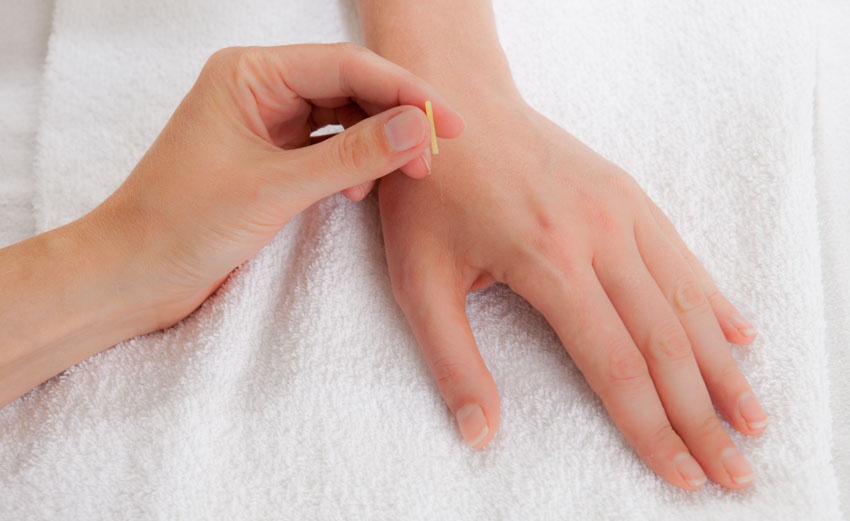
Acupuncture is effective for reducing pain and improving hand function in patients with hand-arm vibration syndrome (HAVD). Tools that vibrate may cause adverse neural and circulatory effects in the fingers, causing numbness, pain, and a blanching discoloration. Alternate terms for HAVD include vibration white finger and occupational origin Raynaud’s phenomenon (a type of secondary Raynaud’s). The condition is typically more prevalent the early morning or when the hands are cold and wet.
Researchers at the Guangdong Hospital of Occupational Disease conducted a clinical trial comparing the treatment of HAVD with pharmaceuticals to pharmaceuticals and warm needle acupuncture. The addition of warm needle acupuncture to the standard treatment protocol resulted in superior patient outcomes. [1] TCM (traditional Chinese medicine) principles support the application of warm needle acupuncture given that the condition is exacerbated by cold and dampness.
After completion of the trial, an electromyography device (Nicolet VikingQuest) was used to assess patients’ median and ulnar nerve conduction. Nerve conduction parameters, including motor nerve conduction velocity (MCV), distal motor latency (DML), compound muscle action potential amplitude (CMAP), sensory nerve conduction velocity (SCV), and sensory nerve action potential amplitude (SNAP), were measured and analyzed. In the warm needle acupuncture group, patients’ MCV, CAMP, SCV, and SNAP presented more marked improvements. DML dropped more significantly when acupuncture was added to the standard pharmaceutical protocol. This indicates that warm needle acupuncture promotes the restoration of axons and benefits myelin sheaths.
The study used a sample of 75 male patients admitted into the Guangdong Hospital of Occupational Disease. The patients were all right-handed and worked in the same factory, polishing products on the production line. They were randomized into either the pharmaceutical control group or the pharmaceutical and warm needle acupuncture group. Patients did not have wounds or peripheral neuropathy central nervous system disorders.
The regular pharmaceutical treatment group received 30 ml of Radix Salvia Miltiorrhiza injection. It was dissolved in 250 mL of glucose injection with a mass fraction of 5.0% and administered intravenously once daily. Mouse nerve growth factor (30 μg) was dissolved in 2 mL of 0. 9% sodium chloride solution and injected intramuscularly. Mecobalamin (500 μg) was taken orally three times daily.
The other group was given warm needle acupuncture in addition to the above treatment regimen. The main points used were as follows:
- EX-UE9 (Baxie)
- TB5 (Waiguan)
- LI4 (Hegu)
Needles (0.3 mm × 50.0 mm) were inserted with a single hand after disinfection. Upon achieving a deqi sensation, moxa was connected to Hegu and Waiguan. Three moxa (20 mm) were used for each point, and needles were retained for 20 minutes. Treatment was given five times a week for four weeks.
In an earlier study, researchers used a similar design. [2] Forty-three patients diagnosed with occupational HAVD were divided into an experimental group and a control group. Before and after treatment, the occurrence of vibration-induced white finger (VWF) was recorded. Upper limb function was assessed using the Disabilities of the Arm, Shoulder, and Hand (DASH) questionnaire. Serum concentration of TNF alpha was detected using ELISA. The experimental group received acupuncture and moxibustion.

Prior to the treatment, DASH scores were not significantly different between the two groups, but post-treatment scores were markedly lower in the experimental group than in the control group (21.94 ±5.79 vs. 35.87 ±3.80). Post-treatment occurrence of VWF in the experimental group was significantly lower than that of pre-treatment. A total; of 88.37% of the pre-treatment serum TNF alpha concentration was above reference range (8.1 pg/ml), and was not significantly different between two groups. However, post-treatment TNF alpha concentration in the experimental group was significantly lower than in the control group (10.51 ± 3.68 pg/mL vs.14.72 ± 8.66 pg/mL. Furthermore, the differences in DASH score and TNF alpha concentration before and after treatment were statistically significant between the groups.
The results of the above studies show that the integration of acupuncture and moxibustion in the treatment of occupational HAVD is effective.
References:
[1] Liu Qingfeng, Guo Jijun, Huang Lirong, Chen Sizhi, Yanmaosheng, Effects of Warm Needling Therapy on Nerve Conduction in Patients with Occupational Hand-arm Vibration Disorder, China Occupational Medicine, August 2021, Vol.48, No.4.
[2] Liu Qingfeng, Wu Qifeng, Zeng Zifang, Huang Yong, Clinical Effect and Mechanism of Acupuncture and Moxibustion on Occupational Hand-arm Vibration Disease: A Retrospective Study, European Journal of Integrative Medicine Volume 23, 2018, BP 109-115.


